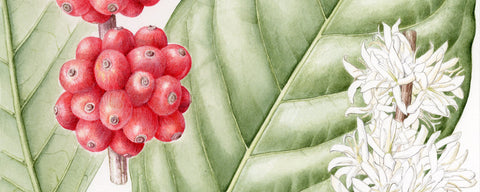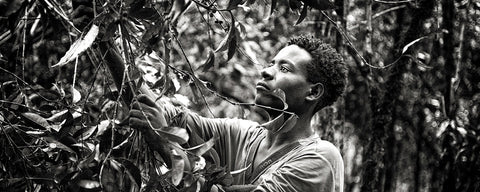First Published - May 27, 2010
Back in 2000 when Jeremy & I first starting giving thoughts to creating Union, it was partly as a reaction to the stories we were hearing following the drop in world coffee prices and how this was causing hardships to producers. In 2002, our first year of roasting, Jeremy participated in the first Cup of Excellence judging in Guatemala. During that trip he visited farms and saw the effect low coffee prices were having on producers. He took photos of the coffee plantations that had been abandoned because farmers couldn’t afford to keep them productive. We heard stories about how these abandoned farms would affect the local communities and cause disruption of rural economies. It compelled us to seek another way to trade, developing the relationship model & buying coffee according to its intrinsic value and quality, & not the vagaries of commodity traders working the markets.
Our approach to direct trade was a simple message but we’ve had to work hard to convince producers that it’s in their interest to plan for the future and agree prices that are sustainable for them. It may take the thrill of the roulette table out of their lives, but it removes the risk.
Now over the years we’ve developed the long term relationships with many producers so it’s been a while since I last talked about the coffee crises of the early 2000’s. This visit to Guatemala brought it right back to me as I was visiting farms that were now in the early days of re-establishing their coffee production again after having been discarded for so long.
Famers like Jose Lopez, who is the legal representative of a co-operative of smallholder farmers in La Libertad, Huehuetenango. His smallholding is 1.5 ha. The first trees we looked at were 2 years old, (farm section called La Fortuna). This farm was abandoned from 2002-5, because of low prices, but 3 years ago he started to reinstate it. It’s taken a long time to get back into condition and won’t be fully productive till 2011. At 1800mASL (5800 ft) it’s very high altitude and within this first section all the shade trees in the farm are indigenous which is unusual as most farmers tend not to use indigenous trees now.
The next section of his farm, also abandoned, is still being worked on to get it back into shape. The trees, a mix of caturra, bourbon, pache, tipica, and Jose explains they are 9 years old, which means they were new when they were abandoned.
The high altitude is a double edge sword; positive impact is no insects and no requirement to use any insecticide spray whatsoever. The negative is the effect of frost burn at this height that causes death to part or complete trees.
I found it disturbing to be continuously reminded about the coffee crises that in my mind was so many years ago. Yet, in the remoter regions of La Liberdad near the Mexico Chiapas border, farmers were talking about an even more complex legacy from that period. Here, abandonment had a more profound impact. Many of the farmers in this region are women, fending for themselves because the men left for the USA. The mounting debts their farms incurred after the crash, forced the men to seek work abroad, and try to send cash home to their families who had nothing. But some of the women hadn’t heard from their husbands in years; the women were abandoned with young families with no option but to learn agronomy and take over the responsibility of coffee farming. I asked the women what help they received, “very little, we employ a hand full of pickers, indigenous mayan, in the season, but we also pick and process our own coffee. Pruning shade trees to ensure the correct amount of sun reaches the coffee is the only task we struggle with and need to get assistance”. Again and again I heard this story, unveiling the legacy of the coffee crises from 2001-2203.
In Todos Santos, Huehuetenango, I was privileged to spend a few days with a small co-operative of 50 Mayan farmers. They only wear traditional hand made clothing and most only spoke their local language, “Mam” so working through 2 translators was tricky but we made good progress explaining the Union code of conduct, and how we seek to improve the working conditions and labour standards of all participants in coffee farming. It seemed to be well appreciated as these farmers are very progressive and work according to the Slow Food philosophy of producing high quality coffee, care for the environment and social development for the farmers. This region of Northern Guatemala was closed to visitors until the end of the1996 civil war, and even after this period travellers did not venture here. The culture of these Maya was not respected by western visitors and this caused tension and problems in the region. The Guatemala government commenced a programme to sensitize the people of this region towards visitors and the outcome is that the Mam are now happy to receive outsiders and enthusiastic to explain their way of life. These farmers told me they were not seeking a buyer, they want a partner, a long term committed relationship. This meeting was like an arranged marriage. The last few years they’d been receiving intensive agronomy training and in 2009 they received funding to construct a new pulping station. Now they produce beautiful coffee so am hopeful this will be a union made in heaven.
Its striking to hear their stories – the oldest member of the co-operative remembers when they first started to grow coffee – nearly 70 years ago. And he stands in front of the coffee tree that he remembers his father planting when he was a 7 year old boy. Back in those days the ground was so fertile, they could just stick seeds into the soil and the trees would grow without any inputs. Nowadays they have to apply organic fertilizer to achieve good production.
We’re looking forward to their coffee arriving at our roastery- during June.


